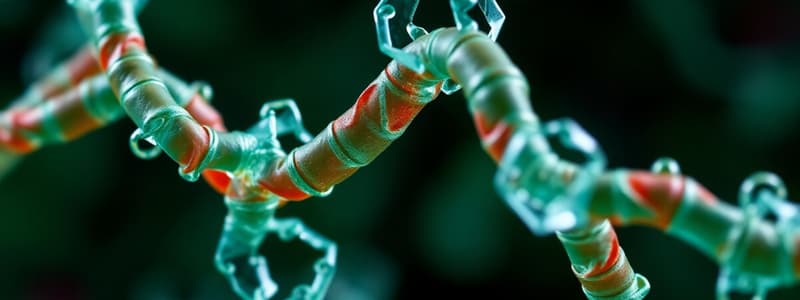Podcast
Questions and Answers
What term is used for the catalytically active form of an enzyme?
What term is used for the catalytically active form of an enzyme?
- Cofactor
- Substrate
- Apoenzyme
- Holoenzyme (correct)
Which factor does NOT affect enzyme activity?
Which factor does NOT affect enzyme activity?
- Color of the solution (correct)
- Substrate concentration
- Temperature
- Enzyme concentration
What is the optimum temperature range for enzymes in humans?
What is the optimum temperature range for enzymes in humans?
- 20-25 °C
- 35-40 °C (correct)
- 0-10 °C
- 70-75 °C
What term describes any substance that decreases the velocity of an enzyme-catalyzed reaction?
What term describes any substance that decreases the velocity of an enzyme-catalyzed reaction?
Which type of inhibition is characterized by the ability to be reversed?
Which type of inhibition is characterized by the ability to be reversed?
What does Km reflect in enzyme kinetics?
What does Km reflect in enzyme kinetics?
Which of the following correctly describes the term 'activity' in enzymology?
Which of the following correctly describes the term 'activity' in enzymology?
What is the unit of enzyme activity defined as changing 1 µmol of substrate in 1 minute?
What is the unit of enzyme activity defined as changing 1 µmol of substrate in 1 minute?
What is the primary function of enzymes in biochemical reactions?
What is the primary function of enzymes in biochemical reactions?
Which class of enzymes is responsible for the transfer of functional groups?
Which class of enzymes is responsible for the transfer of functional groups?
How do enzymes affect the speed of biochemical reactions?
How do enzymes affect the speed of biochemical reactions?
Which statement accurately describes enzyme specificity?
Which statement accurately describes enzyme specificity?
What are ribozymes?
What are ribozymes?
Which of the following factors can affect enzyme activity?
Which of the following factors can affect enzyme activity?
In enzyme kinetics, what does the Michaelis-Menten constant (Km) represent?
In enzyme kinetics, what does the Michaelis-Menten constant (Km) represent?
Which type of enzyme inhibition decreases the reaction rate without permanently altering the enzyme?
Which type of enzyme inhibition decreases the reaction rate without permanently altering the enzyme?
Flashcards
Enzymes
Enzymes
Biological catalysts that speed up chemical reactions within living organisms.
What are enzymes made of?
What are enzymes made of?
Enzymes are mostly composed of proteins. However, some are made of ribonucleic acid (RNA) and are called ribozymes.
How do enzymes affect reaction rate?
How do enzymes affect reaction rate?
The rate at which a reaction proceeds is significantly increased by enzymes, but they do not alter the equilibrium point of the reaction.
What is enzyme specificity?
What is enzyme specificity?
Signup and view all the flashcards
How efficient are enzymes?
How efficient are enzymes?
Signup and view all the flashcards
How are enzymes classified?
How are enzymes classified?
Signup and view all the flashcards
What is activation energy?
What is activation energy?
Signup and view all the flashcards
What are catalysts?
What are catalysts?
Signup and view all the flashcards
Apoenzyme
Apoenzyme
Signup and view all the flashcards
Cofactor
Cofactor
Signup and view all the flashcards
Holoenzyme
Holoenzyme
Signup and view all the flashcards
Active site
Active site
Signup and view all the flashcards
Enzyme Activity
Enzyme Activity
Signup and view all the flashcards
Inhibitor
Inhibitor
Signup and view all the flashcards
Reversible inhibition
Reversible inhibition
Signup and view all the flashcards
Km
Km
Signup and view all the flashcards
Study Notes
Enzymes
- Enzymes are biocatalysts, speeding up reactions by lowering activation energy.
- They are not consumed in the reaction.
- Enzymes are highly specific for their substrate and reaction.
- Most enzymes are proteins, but ribozymes are catalytic RNA.
- Enzymes change reaction rate (efficiency), not the reaction equilibrium.
Learning Objectives
- Describe enzymes and their common properties
- List the enzyme classifications correctly
- Describe factors changing enzyme activity
- Explain the relationship between Km and activity
- Explain enzyme inhibition and types of inhibition
Metabolic Reactions
- Enzymes catalyze metabolic reaction, speeding up anabolic and catabolic pathways.
- Enzymes modify molecules, facilitate reactions, and aid in molecule transport.
- Some reactions involve multiple steps with multiple enzymes.
Glycolysis
- Glycolysis is a metabolic pathway where glucose is broken down to pyruvate.
- Enzymes such as HK, PGI, PFK, ALDO, and others catalyze specific steps in this pathway
Activation Energy
- Activation energy is the energy needed for a chemical reaction to start.
- Enzymes lower the activation energy required for reactions to occur.
- Enzymes speed up reactions by lowering the energy barriers and making them more favorable.
Activation Energy and Catalysts
- Catalysts speed up reactions.
- Catalysts lower the activation energy of reactions without being consumed in the process.
- Enzymes are biological catalysts.
Enzymes (Biocatalysts)
- Enzymes increase reaction rates.
- Enzymes are biocatalysts that increase the reaction rate
- Enzymes bind to substrates and make reactions faster.
Properties of Enzymes
- Enzymes are proteins (except ribozymes).
- They exhibit reaction specificity, meaning they only work on particular reactions.
- They demonstrate substrate specificity (bind to a specific substrate).
- Enzymes are highly efficient, increasing reaction rate up to millions of times faster.
Efficiency
- Enzyme-catalyzed reactions occur much faster than non-catalyzed ones.
- Carbonic anhydrase is exceptionally fast, hydrating CO2 molecules.
Specificity
- Reaction specificity: A given enzyme catalyzes a specific reaction type.
- Substrate specificity: A given enzyme uses a specific molecule or chemically related molecules.
Enzyme Nomenclature (Classification)
- Enzymes are classified by EC numbers, a hierarchical system.
- A classification system exists to differentiate enzymes by the specific reactions they catalyze.
Enzyme Kinetics and Km
- Km represents enzyme affinity or how well an enzyme binds to its substrate.
- A smaller Km signifies a higher affinity.
- Vmax is the maximum reaction rate of an enzyme when saturated with substrate.
Km, A Clinical Example
- Km values for alcohol dehydrogenase and aldehyde dehydrogenase vary depending on factors like the enzymes involved and the genes.
- Lowering the Km of aldehyde dehydrogenase decreases the toxicity of acetaldehyde, relating to alcohol metabolism.
Regulation of Enzyme Activity
- Enzyme activity is controlled by numerous processes.
- Enzyme amount, modification, and location regulate enzyme activity.
- Non-covalent and covalent modifications, and compartments regulate activity.
Regulation of Enzyme Activity (continued)
- Phosphorylation/Dephosphorylation:
- Kinase activates the enzyme by adding a phosphate.
- Phosphatase deactivates the enzyme by removing the phosphate.
- Feed-forward activation:
- A reaction activates a cascade of enzymes
Regulation of Enzyme Activity (Continued)
- Feed-back inhibition:
- A reaction product inhibits an earlier enzyme step.
- Compartmentalization:
- Enzymes are localized to specific cellular compartments.
- Isozymes:
- Different forms of an enzyme with varying activities
Enzyme Structure (Active Site)
- Apoenzyme: Protein portion of an enzyme.
- Cofactor: Non-protein part of an enzyme (metal ion or coenzyme).
- Holoenzyme: Complete enzyme with cofactor and apoenzyme.
Enzyme Activity
- Activity (V) is the speed or rate at which an enzyme works.
- Unit activity: enzyme activity that converts 1 µmol substrate in 1 minute under optimal conditions.
Factors Affecting Enzyme Activity
- Enzyme concentration: increasing concentration means more reactions happen faster.
- Substrate concentration: higher substrate leads to faster reaction initially, but only to a certain point.
- Temperature: Enzymes operate best at particular temperatures.
- pH: Optimal pH range varies based on enzymes and the environment.
- Inhibitors: Molecules that reduce enzyme activity.
Studying That Suits You
Use AI to generate personalized quizzes and flashcards to suit your learning preferences.




